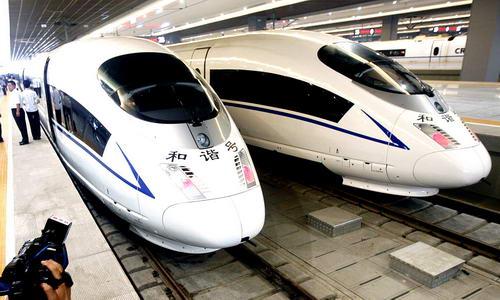BEIJING - The Shanghai-Nanjing high-speed rail service, aimed at boosting development in one of the country's major economic zones, opened to passengers on Thursday.

High-speed trains prepare to take of from Shanghai to Nanjing on Thursday. The new express rail service between the two cities, with speeds of up to 350 km per hour, has become the fastest inter-city line in the country. [CHEN FEI / XINHUA]
The new service, with trains running at up to 350 km per hour, has halved the travel time between Shanghai and Nanjing, capital of the neighboring Jiangsu province.
The service, which covers the 301-km route in just 73 minutes, carving 80 minutes off the previous time, has become the fastest inter-city train in the country.
In the initial operation phase, high-speed trains will run 92 round trips on the route. The Ministry of Railways plans to raise the number to 120, but no timetable has been set.
Ministry spokesman Wang Yongping said the new line will "help boost regional modernization" and the number of rail travelers in the region.
Among the 21 stops on the route are the eight most prosperous cities in the Yangtze River Delta region, including Suzhou and Wuxi, which contribute 61 percent to Jiangsu province's GDP.
Wang cited a railway expert as saying that building the Shanghai-Nanjing inter-city railway was no easier than building the Qinghai-Tibet railway.
The Qinghai-Tibet rail line crosses 550 km of permafrost. Temperature changes could potentially alter the shape of the permafrost, threatening the stability of the rail bed and increasing the possibility of accidents. Its operation, which began in 2006, was hailed a technical milestone.
In the case of the Yangtze River Delta region, the alluvial plain is prone to subsidence, which is not an ideal geological condition for building high-speed railways.
"If we say building the Qinghai-Tibet railway was like laying tracks on frozen tofu, building the Shanghai-Nanjing railway was working on tender tofu," he said.
The line was approved by the State Council as part of the plan for railway construction in the Yangtze Delta in 2005 and construction on the project began in 2008.
According to government data, the region, which covers 2.1 percent of the country's territory, contributed more than 21.4 percent to China's GDP last year.
China Daily-Xinhua





